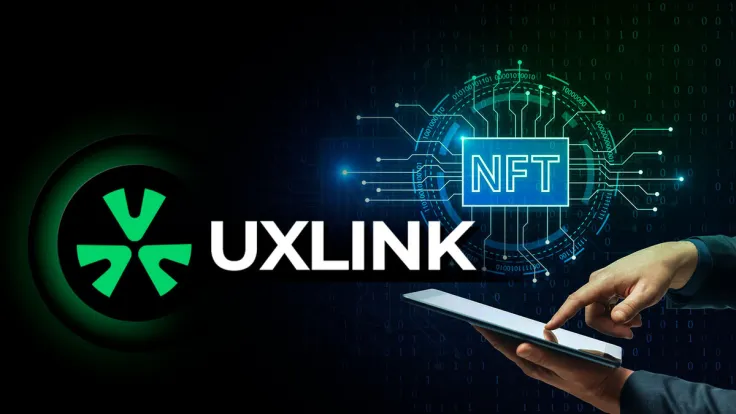
Disclaimer: The opinions expressed by our writers are their own and do not represent the views of U.Today. The financial and market information provided on U.Today is intended for informational purposes only. U.Today is not liable for any financial losses incurred while trading cryptocurrencies. Conduct your own research by contacting financial experts before making any investment decisions. We believe that all content is accurate as of the date of publication, but certain offers mentioned may no longer be available.
Built on the top of Telegram platform, UXLINK is a social platform and infrastructure focusing on connecting acquaintances. Since its launch in April 2023, UXLINK has emerged as the leader in traffic among the new generation of social products, owing to its unique link-to-earn gameplay.
UXLINK leverages novel mass adoption strategies
According to the project's official website, UXLINK boasts over seven million registered users from 190 countries and regions, with over 100,000 groups reaching over eight million users. Recently, UXLINK concluded its first phase of NFT distribution, laying the groundwork for the upcoming large-scale UXLINK token airdrop and future layered operations.
Mass adoption is a pivotal issue in the Web3 world and a fundamental concern for all application-layer entrepreneurial teams. It is also the primary reason why sectors such as gaming, social networking and RWA attract significant attention.
In light of recent developments, the approval of Bitcoin ETFs and imminent listing and trading of Ethereum ETFs has intensified the call for truly "killer" Web3 applications in the macro environment.
UXLINK adoption strategy highlights its infrastructure and community role. The app utilizes Telegram's existing user base and relationships within its ecosystem to build trust-based social connections on-chain.
The platform integrates incentive layers within Telegram - preventing duplication of external dApps - improves user retention and engagement through social networking and establishes a solid groundwork for ecosystem collaboration and growth.
The social aspect's retention and engagement surpass those of gaming or "play-to-earn" platforms. UXLINK leverages social networking as its primary gateway, enhancing its stickiness for further ecosystem collaborations and more efficient distribution of capabilities.
UXLINK pioneers link-to-earn approach in user onboarding
The protocol encourages users to share invitation links to join the "UXLink TG community," allowing invitees to earn UXUY points. To accomplish this goal, it facilitates the swift establishment of real-world social graphs on the blockchain through link-to-earn trust links.
It enables easy propagation of social connections from one-on-one interactions, laying the groundwork for group dynamics and network effects.
For developers, it provides dApp-layer social relationship data to developers via protocol-layer APIs. The AWC protocol manages on-chain identity and asset relationships, assisting AI models in behavior analysis and recommendations.
UXLINK, therefore, actively collaborates with external developers to enhance platform functionality and expand ecosystem capabilities.
UXLINK utilizes self-built infrastructure to address platform needs. The RWS protocol focuses on social graph issues, improving recommendations and growth opportunities. The AWC protocol manages on-chain identity and asset relations, supporting developers in user understanding and AI model analysis and recommendations.
UXLINK already collaborates with Web3 wallets like Binance and OKX for UXUY point and NFT distribution. It has also introduced the "UXLINK Social Ecosystem Alliance," expanding the developer community and third-party project collaborations, resulting in rapid revenue and profit growth.
UXLINK has numerous use cases and powerful community incentives
The protocol implemented tiered operations through the issuance of four levels of community NFTs. It always reserves a significant portion (65%) of incentives for the community.
Active users can receive long-term incentives in UXLINK and ecosystem projects. Developers utilize UXLINK to pay for protocol, data and dApp usage fees, with 85-90% allocated to community users.
Users leverage UXLINK as a transaction commissions tool, gaining airdrops and investment opportunities. Partners pay UXLINK for customer acquisition assistance. This is characterized by a finite supply and specific use cases, fostering a sustainable deflationary model.
What can on-chain data tell us about UXLINK?
Given uncertainties surrounding off-chain data sources and methodologies, this section predominantly studies the UXLINK on-chain landscape on Arbitrum (ARB).
Given that UXLINK has not yet undergone its token generation event, we are projecting the future number of UXLINK token holders by leveraging on-chain scores and NFT holdings data. Per insights from Dune Analytics, UXLINK presently showcases an impressive count of over 4.4 million on-chain scores and NFT holders, with more than 1.5 million individuals holding NFTs. Notably, only community members meeting specific score criteria have the privilege to mint NFTs and subsequently become NFT holders, qualifying them for airdrop benefits.
From this data, it can be reasonably inferred that UXLINK likely already boasted around 1.5 million token holders prior to its official listing, a figure in close proximity to the post-listing scale of NOT. Looking ahead, we anticipate further growth in the pre-TGE holder count, potentially setting the stage for one of the most comprehensive airdrops in history in terms of coverage.
According to DappRadar, UXLINK boasts over 500,000 daily active users, with respective figures of 574,000, 1 million and 3.8 million for 24 hours, 7 days and 30 days, closely matching official disclosures.
With UXLINK's strong establishment of a Web3 social network among users and its ongoing airdrops to active users post-listing, there are solid indications that UXLINK will effectively sustain user engagement.
UXLINK, on the other hand, follows a dual-token model comprising a utility token (UXUY points) and a governance token (UXLINK).
UXUY points are generated through a proof-of-linkage (POL) mechanism with no preminting. Users earn tokens by inviting others and contributing to the ecosystem, with rewards gradually decreasing based on time, network connections and total network size.
The total token supply of UXLINK is 1,000,000,000 tokens, with 65% allocated to community contributors and developers (POW, link-to-earn and build-to-earn), and the remaining 35% distributed among investors, the team and project development.
Wrapping up
In the previous cycle, STEPN exemplified mass adoption, while in the current cycle, UXLINK has emerged as a prominent player. Their rapid success can be attributed to their focus on creating products designed for mass adoption, rather than targeting specific niches. UXLINK extends beyond typical Web3 messaging platforms with its low barrier to entry, engaging experiences and compelling incentives ingrained into their core principles. These factors contribute to their ability to attract a broad user base.
By offering accessible, engaging and rewarding experiences, cryptos like UXLINK are bridging the gap between current user behaviors and the potential of Web3, paving the way for widespread adoption in the near future.
 Caroline Amosun
Caroline Amosun Denys Serhiichuk
Denys Serhiichuk Tomiwabold Olajide
Tomiwabold Olajide Alex Dovbnya
Alex Dovbnya